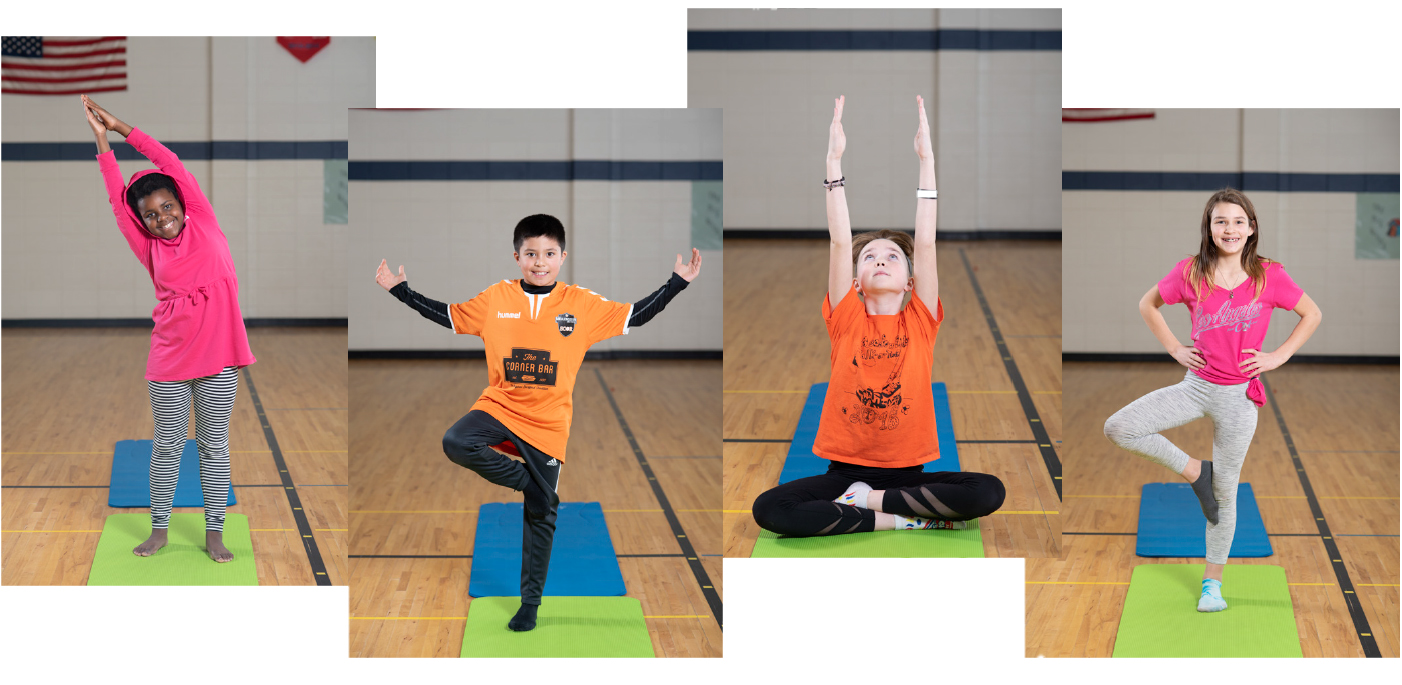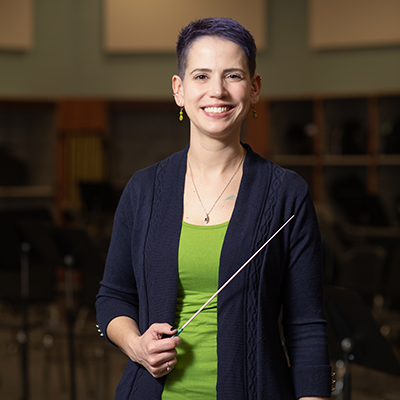Members Bring Mindfulness to Schools

By Brenda Ortega
MEA Voice Editor
MEA member Tamara Reaume asked the fourth graders lying flat on exercise mats in front of her to sit on their hands with feet in the air.
“Remember, your legs do not have to be straight, friends,” the Rockford paraeducator told about two dozen youngsters whose legs weaved skyward like stalks of wheat in a breeze. “Ready? Now, your toes are going to point to your face.”
Stockinged feet shifted to form right angles with shins. “Notice where you feel the stretch… in the backs of your legs, right?”
Whispered “ohs” and “ahs” blended with muted chatter in the multi-purpose room.
“Now point your toes to the ceiling, and notice how the stretch changes.”
“Whoa,” one boy said to no one in particular.
“I feel it in my thighs,” a girl noticed.
“Good observation,” Reaume replied. “Now squeeze your toes and let them happy dance—they’re not stuck in your stinky shoes. Just move.”
Legs wiggled and scissored aloft.
“Make circles with your feet.”
Feet danced and bicycled.
“You can do this at night if you’re having trouble falling asleep,” Reaume reminded them. “It tells your nervous system, It’s OK to settle down. It’s very calming.”
So simple. Equally profound.

Reaume is one of many educators and mental health professionals in the vanguard of a movement bringing a practice known as mindfulness to schools across Michigan and the U.S.
More than a fun extra, mindfulness initiatives aim to help address growing concerns about youth mental health as teen suicide rates are increasing and studies show more than one-third of American young people suffer from anxiety.
“We’re giving kids tools and life skills to help navigate stress and issues they’re facing with this fast-paced environment they’re now living in,” Reaume said. “We do a lot of focus on breath work. So many are disengaged from their body, and it just brings them back into themselves.”
Reaume evolved a personal yoga practice she began in 1994 into obtaining certification for teaching it to kids and volunteering sessions in her own child’s classroom—to bringing mindful movement to Kent County schools, now in her third year.
 Through a grant from the Parent-Teacher Organization at Meadow Ridge Elementary School, she divides her time between traditional paraeducator duties and mindfulness sessions that rotate her through classes, from developmental kindergarten to fifth grade, every two weeks.
Through a grant from the Parent-Teacher Organization at Meadow Ridge Elementary School, she divides her time between traditional paraeducator duties and mindfulness sessions that rotate her through classes, from developmental kindergarten to fifth grade, every two weeks.
In addition, Reaume runs two five-week afterschool sessions for area students and provides one lesson in mindful movement to freshmen taking a stress management class at the high school.
Her regular sessions run 20 minutes and include a variety of movements that couple breathing and attention, meant to ground students and show them how to keep from being captive to negative emotions.
Balancing postures allow students to practice the skill of focusing, and a three-minute period of rest and stillness at the end asks them simply to stop. Stop moving, thinking, stressing.
“At first it was a challenge,” she said. “It was not easy to ask a child, especially a five-year-old, to be still. But it is amazing, because even those that struggle the most with being still welcome it and want it. It tells me there must be a need.”
Students in her fourth-grade class confirmed their need, volunteering examples of which movements they use in their lives outside of class—and when.
“I use mountain breath when I’m upset and thinking bad on myself, and it makes me feel better,” said Brogan Burns, referring to a move in which a person stands in mountain posture while inhaling, and lowers palms together in front of the chest while exhaling.
Jordan Beerthuis said he uses baby posture—lying on his back and lifting his knees to grasp his feet with both hands—to quiet his mind at night. “Sometimes I try to go to sleep but I can’t, so I think about good things and put all bad things aside, and it helps me calm down.”
A more introverted student said she uses banana posture—hands clasped above the head and tilting side-to-side in an arch—to feel stronger. “It helps me stay active and feel like I can do more,” said Haley Armock.
Skeptic to Supporter
Across the state in Flint, MEA member Jenny Purman is an advocate for mindfulness education, but she wasn’t always. Five years ago, she walked by the classroom of a teacher doing mindful breathing with his students and thought, Look at him. Doing something hokey. Wasting time.
A year later, she was working with a large and difficult group of 20 students in her role as a pull-out reading interventionist at Durant-Tuuri-Mott Elementary School.
“They couldn’t settle down. They couldn’t focus on what we were doing or reading or even what the lesson was about.”
In desperation, she decided to try mindfulness with that challenging group. Fortunately, Flint’s Crim Fitness Foundation had started a campaign to bring the practice to all of the city’s children.
Purman had been given free access to a plug-and-play curriculum for daily 10-minute mindfulness lessons with video support. “I wasn’t sure what I thought about it at first,” she said. “The kids thought it was kind of silly, but I noticed a little bit, too, that they kind of liked it.”
She knew she had to buy in if she wanted kids to engage, so she did—and saw a change within two weeks. “They started talking about how they felt better and more able to focus on what we were doing because they had 10 minutes to calm down and switch from one class to the next.
“That’s when I finally believed. It works. I saw it with my own eyes, and I had the most challenging group.”
This year, Purman was reassigned to a fourth-grade classroom, where she does a daily 10-minute mindfulness lesson after lunch when kids are ramped up. The curriculum she uses—Inner Explorer—does not include as much movement as Reaume’s lessons but mainly targets breathing, relaxation, and focus.
The approach is not a cure-all, she said. Sometimes students struggle to stay engaged or complain when a lesson repeats previous instruction. “They don’t realize they have to continue to practice before it becomes a habit.”
But more often than not, the 10 minutes spent on mindfulness make the afternoon more productive—not only for students but herself. “It benefits all of us, because I’m getting anxious and upset when the kids aren’t listening or they’re angry at each other. When they’re calm and I’m calm, it makes things go so much better.
“Just today, I was giving them directions, and they weren’t listening, and the little boy next to me said, ‘I think you need to shark fin right now.’ That’s a strategy where we just take 10 seconds to reset. So I think it would help a lot of teachers, because it’s very stressful in our job right now.”
On a recent gray winter afternoon, Purman’s fourth graders did a lesson that asked them to recall emotions—negative and positive—and practice letting them go with each exhale of deep, steady breath. Afterward, they wrote or drew pictures about the experience in journals.
Most of the students are in their third year practicing mindfulness in school. Asked about its effectiveness, many said they employ their favorite techniques to combat negative emotions outside of class or to fall asleep at night. Some said they’ve taught family members.
“It puts me to sleep at night and makes me calm down and feel good about myself,” said Sandrese Green.
“People can get really mad at simple stuff,” said Egypt Cleveland. “We need mindfulness so we can calm our bodies down before we do something crazy.”
Now in her 26th year of teaching, Purman has stepped up to be one of 20 Mindfulness Ambassadors for the Crim Fitness Foundation’s initiative in the schools. She trained to become certified to teach yoga K-5, and she volunteers to do outreach to others who want to learn.
Without it, Purman believes she would have retired early after returning to the classroom from nine years as an interventionist to find kids in crisis and no tools to help. “Kids cannot check their baggage at the door, and they can’t do math or reading until their first need is met.
“This absolutely has transformed the way I teach. I don’t know what I would do without it.”
Watch a Crim Fitness Foundation video of Purman and her students in a lunchtime mindfulness meet-up she ran last school year at tinyurl.com/flintmindfulness.
Tools for ‘toxic stress’
Mindfulness is mental fitness that builds resilience and emotional intelligence in all types of people, but it’s especially beneficial for students in Flint affected by “toxic stress” from the water crisis, said Sarah Sullivan, director for the Mindfulness Initiative at the Crim Fitness Foundation.
The foundation began its Flint mindfulness program on a small scale in 2012, focused on Crim staff coming into classrooms to offer periodic lessons. In 2014, the Crim was selected as the lead agency in the city’s Community Education initiative to address the needs of the whole child.
Meanwhile, state government failures exposed Flint residents to dangerously high lead levels in drinking water from 2014 through 2016, inflicting additional trauma on a city already struggling with widespread poverty from decades of losses to its economic base.
The foundation shifted its approach in 2015 to offer training and curricular support for all 518 teachers and support staff in Flint Community Schools and 215 school employees in five neighboring districts to encourage large-scale culture change within and across buildings.
“Research suggests that damage to the brain, such as the harm that lead can do to the prefrontal cortex, can be strengthened through mindfulness training,” Sullivan said. “Teachers often find the benefits of student attention, time on task, and fewer discipline issues outweigh the 5-10 minutes a day it takes to do.”
After the program’s first year, 73 percent of fourth graders surveyed said mindfulness helped them focus and make better decisions, according to a study by a researcher at Michigan State University. Sixty percent of surveyed students said mindfulness helped them avoid fights.
Since its inception, the Crim foundation’s initiative has trained more than 1,000 Flint-area school personnel in strategies to deliver evidence-based, secular mindfulness education.
For other educators interested in mindfulness, Sullivan said, “My best advice is to start with their personal practice and develop that, and then connect with other groups to learn curricula or the skills to share it with young people.”

‘It’s a movement’
Personal journeys in mindfulness are exactly what led three MEA members to seek out additional training to bring the practice to school districts in Troy, Mt. Pleasant, and Grand Blanc. All three sought certification from a California-based non-profit, Mindful Schools.
Laura Gourlay, a counselor in Mt. Pleasant Schools for 33 years, began practicing mindfulness several years ago when she was experiencing personal struggles with stress, anxiety, and sleeplessness. The benefits to her mental health were profound, she said.
As she grew in her practice, she realized she was spending much of her time at the middle school responding to the same students repeatedly. “I wondered if I could do mindfulness with kids. I thought I was going to revolutionize the world, you know? So I googled mindfulness and kids, and I discovered that it’s a movement. And it was already well established in many places.”
Gourlay developed a plan to deliver mindfulness instruction in various K-5 classrooms, and got school board support. She began combining mindfulness lessons and counseling duties in 2014.
Teachers appreciate the weekly lesson, and some are comfortable to continue on days when Gourlay doesn’t come in, she said. “They’ve got the common vocabulary now. They can say, ‘Let’s turn the lights down and find our mindful body and just breathe together a little bit.’”
Watch a video featuring interviews with Mt. Pleasant staff and students discussing the mindfulness program, produced by Gourlay and Central Michigan University broadcasting graduate student Laura Shureb, at tinyurl.com/mindfulmtpleasant.
Stephanie Snider began her personal yoga and mindfulness practice around the same time she started as a social worker in Troy Schools, 17 years ago. But she didn’t realize how powerful it was until her 18-year-old daughter faced—and beat—a life-threatening illness in 2012.
“It hit me that my mindfulness practice helped me get through that time. It was so impactful; I started looking for ways to bring this to the people I work with and the students I work with.”
A few years ago Snider completed 12 weeks of online training to begin delivering mindfulness curriculum in two classrooms at her elementary school to start. Today that number is 12.
“I teach kids to use their breath as an anchor to refocus and get back to the present moment,” she said. “They tell me, ‘I was worried, but I used my breath.’ Or they’ll say, ‘My brother and sister were picking on me, so I went to my room and used my mindful breath.’ They get it.”
Last summer she offered an optional introduction to mindfulness class for educators, and 150 people from her district showed up. “It’s been an amazing journey these past three years.”
Jennifer Casper discovered yoga and meditation helped her combat anxiety triggered by the birth of her first child in 2009. It wasn’t until five years later—during a webinar through Genesee Intermediate School District—she learned about mindfulness in schools.
Advanced in her own practice, Casper completed a year-long training and earned her certification to teach mindfulness in 2017. She had already been trying strategies with her middle school Spanish students in Grand Blanc for two years, and the feedback was positive.
Now she teaches two sections of mindfulness per day, pushing in to 35 teachers’ classrooms who requested it. “When I hear teachers say, ‘We took a mindful minute today; thanks for giving me that tool,’ or ‘I’ve noticed this student using breathing techniques before they reacted; thank you,’ or ‘There’s so much I’m learning about how we react emotionally,’ it’s very humbling.
“There is no magic bullet to solve all of our problems, but it’s getting us talking and we’re headed in the right direction.”
[dt_divider style=”thick” /]
RELATED STORIES:
Above and Beyond – An MEA member in Brighton has spent 10 years developing a first-in-the-nation program to bring service dogs to every building in the district, helping to address students’ social-emotional needs. What’s more, the program is completely funded by the community.
Breaking the Silence – School districts across Michigan are facing an alarming rise in student mental health issues, along with increasing rates of youth suicide. Read more about what some districts are doing to help bring the issue out into the open and offer students tools to address the crisis.


